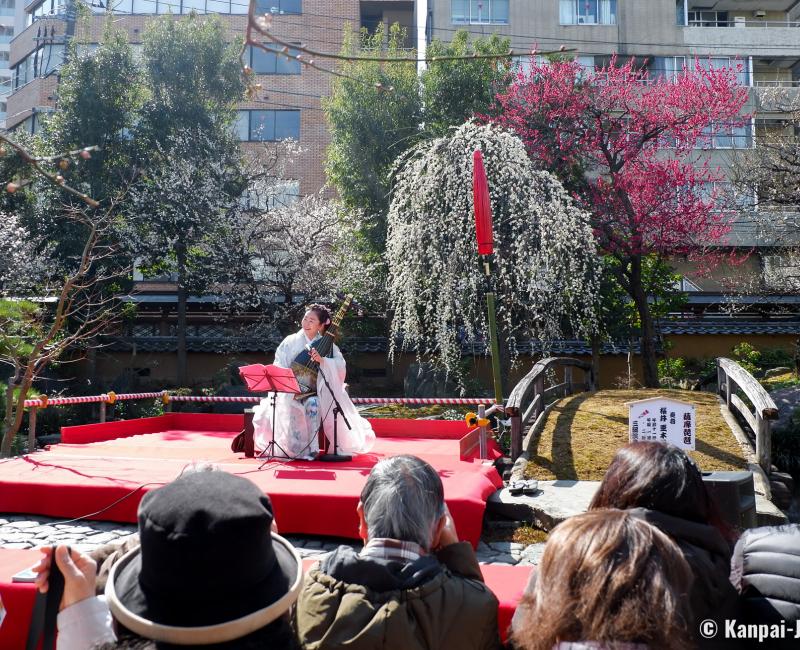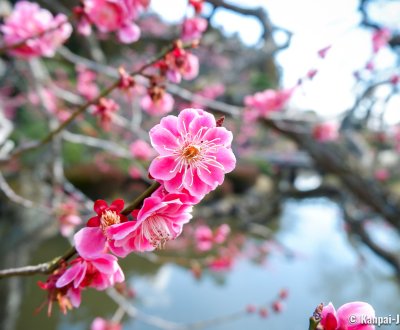Japanese Plum Trees: First Blossoms of the Year
Blooming Japanese Apricots
The parade of seasons in Japan returns with almost clockwork regularity. In early Spring, cherry trees or sakura 🌸 are in the limelight during (o)hanami, when their sublime flowers become objects of contemplation.
Unfortunately, they sometimes overshadow the earlier, yet not less beautiful, blossoming of another tree, the Japanese plum tree (Prunus Mume). Enthusiast onlookers often confuse it with sakura, whose blossoms appear a few weeks later. There are however early cherry varieties blooming in Japan at the same time as plums, such as the kawazu-zakura, kan-zakura and kan hi-zakura.
Plum trees or ume 梅 in Japanese come out in full blossom at the end of winter as the herald of the coming Spring.

Japanese gardens and parks are colored with plum trees’ rose 🌹-hued blossoms, and sometimes white or yellow flowers, depending on the species, and a strong, characteristic perfume is wafting into the air. Plum tree flowers generally have five petals.
As for the fruit, it can be described as having the taste of both plum and apricot (a more common name for the plum tree is "Japanese apricot tree"). It is rather acid and is usually processed, to make liquors such as the famous umeshu (梅酒). Japanese people also enjoy umeboshi (梅干), pickled plums, whose tangy sour-sweet taste enhances the flavor of onigiri 🍙 rice balls.
Plum trees bloom calendar between January and March
In the most popular places such as Tokyo or the Kansai region, one can enjoy their sight as early as February and until mid-March before the sakura take over.
Depending on the region and the latitude, blossoming may occur from the beginning of the year (in the South) and last until early May (in the North).
Where to attend Ume matsuri?
Plum flowers being the first to blossom, they became an incentive to hold dedicated festivals, called Ume matsuri. Shrines and temples, especially those dedicated to Sugawara no Michizane (Tenjin), who particularly favored plum flowers, are keen to hold them.

Here are a few examples of festivals or famous places where Japanese plum blossoms can be admired.
Best plum blossom spots in Tokyo and surroundings
- In Tokyo, among the most notable places are Hanegi Park in Setagaya (650 trees), the Koishikawa Korakuen Garden, Kyu Shiba Rikyu Garden, Shinjuku Gyoen Garden, Baji Koen Park and Ikegami Baien in Ota; or else the shrines of Yushima Tenjin, Ushi Tenjin Kitano and Kameido Tenjin; from early February to early March.
- Kairakuen in Mito, one of the most beautiful gardens in Japan (just over an hour by train, north of Ueno): the festival is held every year from mid-February to the end of March and dedicated to the contemplation of the 3,000 trees in the garden.
- Umeno Park in Ome (less than one hour by train, west of Shinjuku) and its 1,500 trees, one of which is three hundred years old. In the same area, Yoshino Baigo harbors 25,000 trees of 100 different varieties.
- The Takao Plum Village offers a 4,5 kilometers long walk along the former Edo Koshu Kaido Road in Hachioji, lined by numerous plum bushes (10,000 trees displaying white and red flowers).
- Yokosuka’s Taura park or Ume no Sato (in Tokyo Bay) and its 2,700 plum trees.
- In the Mount Fuji area, Odawara City holds a yearly Ume Matsuri; the same goes for Atami Baien in Shizuoka City.

Best plum blossom spots in Kyoto and surroundings
- In Kyoto, the best spot to admire plum blossoms is Kitano Tenmangu with its thousands of trees. Jonangu is also interesting for its forest of weeping plums, as well as Umenomiya Taisha grand shrine in the west of the city and Zuishin-in temple near Yamashina, for its late blooming slightly overlapping the sakura season.
- In Osaka, the Banpaku Park in the North (150 different varieties) takes precedence over the castle’s surroundings. Domyoji Tenmangu is also worth mentioning.
- In Wakayama, visit the wonderful Minabe Bairin in the mountain, that is said to be the biggest plum garden in Japan.
- In the Kansai area, the main places of interest are Hikone castle and Nara’s park.
Lastly in the south of Japan, Dazaifu’s Tenmangu near Fukuoka harbors no less than 6,000 Japanese apricot trees!
It is to be noted that the word hanami is seldom used for plum trees and is typically used in relation to the cherry blossoms.

